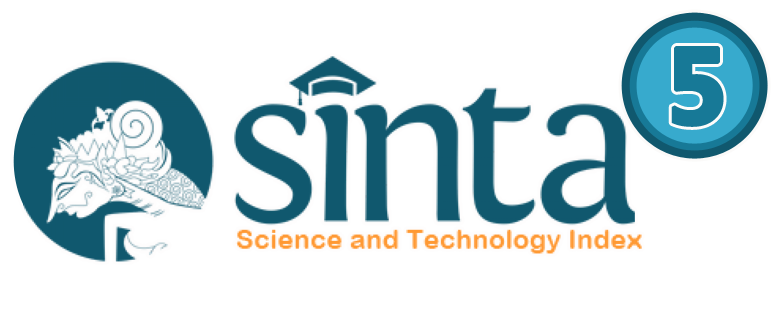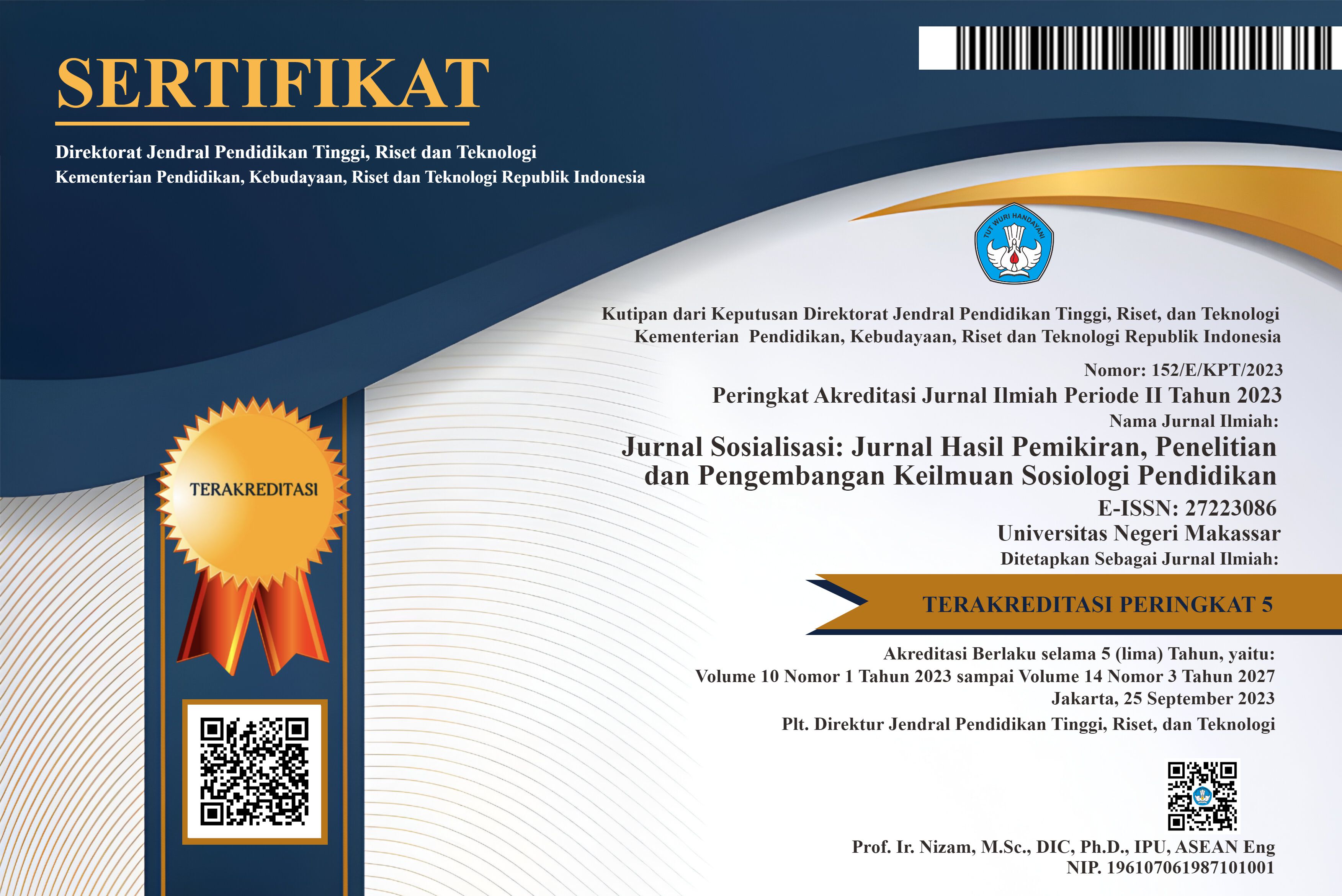Transformasi Epos I La Galigo dalam Bentuk Cerita Bergambar Sebagai Media Visualisasi Pembelajaran IPS: Inovasi atau Tantangan?
(1) Universitas Pendidikan Indonesia
(2) Universitas Pendidikan Indonesia
(3) Universitas Pendidikan Indonesia
(4) Universitas Pendidikan Indonesia
(5) Universitas Negeri Makassar
(*) Corresponding Author
DOI: https://doi.org/10.26858/sosialisasi.v1i2.51144
Abstract
This research is based on important developments in historiography which are critical of tradition as a source of history. Traditional cultural heritage can be found in folklore around the world, including Bugis folklore in Epic I La Galigo which is a source of personality identity for South Sulawesi, Indonesia which must be passed on to the younger generation. This condition demands that the Bugis folklore, Indonesia in the First Epic of La Galigo must be transformed according to the demands of technology with fun, creative and innovative learning. The purpose of this study is to examine the cultural value of Bugis folklore, South Sulawesi, Indonesia in the Epic I La Galigo as a source of social studies learning, and to find out the transformation of Bugis I La Galigo folklore as an innovation or challenge-based social studies learning resource. The research method used is the literature study method by reviewing the literature from various criteria ranging from books, journals or articles and documentation at the La Galigo Museum. The results of the study show that the cultural values in Epic I La Galigo are: (1) Siri' and Pesse', (2) Sumangeq and Inninawa, (3) Preservation of the environment, (4), Lempuk (honest), (5) Getteng (steadfast on the establishment) and (6) Mutual respect. The transformation of Bugis folklore in I La Galigo is an innovative social studies teacher's creative pedagogy by improvising through the development of material content into three media: (1) an oral tradition based on picture story media, (2) an oral tradition based on video animation media as visualization, and (3) webtoon-based media. This research is expected to be a responsive social studies learning transformation movement with a technology-based approach, so that teachers and students are qualified and skilled at innovating through folklore.
Keywords
Full Text:
PDFReferences
Abidin, F. A. Z. (2007). Siri, Pesse ‘dan Were Pandangan Hidup Orang Bugis “dalam Siri ‘dan Pesse Harga Diri Manusia Bugis. Makassar: Pustaka Refleksi.
Arsawan, I. W. E., Koval, V., Rajiani, I., Rustiarini, N. W., Supartha, W. G., & Suryantini, N. P. S. (2020). Leveraging knowledge sharing and innovation culture into SMEs sustainable competitive advantage. International Journal of Productivity and Performance Management.
Asri, D. P. B. (2018). Perlindungan Hukum Terhadap Kebudayaan Melalui World Heritage Centre UNESCO. Jurnal Hukum Ius Quia Iustum, 25(2), 256–276.
Axel, O. (1992). Epic Laws of Folk Narrative. Alan Dundes: Roeman & Littlefield Publishers.
Bahri, J. dan A. dewi. (2021). Integrasi Nilai Karakter dalam Pembelajaran Sejarah. Media Sains Indonesia.
Cummings, W. (2002). Making blood white: Historical transformations in early modern Makassar. University of Hawaii Press.
Darmapoetra, J. (2014). Suku Bugis: pewaris keberanian leluhur. Arus Timur.
Darvin, R., & Norton, B. (2015). Identity and a model of investment in applied linguistics. Annual Review of Applied Linguistics, 35, 36–56.
Delors, J., Amagi, I., Carneiro, R., Chung, F., Geremek, B., Gorham, W., Kornhauser, A., Manley, M., Padrón Quero, M., & Savané, K. S. (1997). La educación encierra un tesoro: informe para la UNESCO de la Comisión Internacional sobre la Educación para el Siglo Veintiuno. Unesco.
Dhahri, I., & Haris, H. (2019). Degradation of Siri’Na Pacce Cultural Values in The Bugis-Makassar Community. International Conference on Social Science 2019 (ICSS 2019).
Evelyn, M., Ardana, I. G. N., Erg, M., & Handoko, C. T. (2013). Perancangan Visual Novel Epos La Galigo Dari Kebudayaan Suku Bugis. Jurnal DKV Adiwarna, 1(2), 11.
Gilbert, S. M., & Gubar, S. (2020). The madwoman in the attic: The woman writer and the nineteenth-century literary imagination. Yale University Press.
Giroux, H. A. (2002). Breaking into the Movies: Film and the Politics of Culture (Malden, MA. Blackwell.
Gonggong, A. (2003). La Galigo, Menelusuri Jejak Warisan Sastra Dunia. Pusat Studi La Galigo Divisi Ilmu Sosial dan Humaniora Pusat Kegiatan Penelitian Universitas Hasanuddin.
Hasni, H., Supriatna, N., Sapriya, S., Winarti, M., & Wiyanarti, E. (2022). Integration of Bugis-Makassar Culture Value of Siri’Na Pacce’through Social Studies Learning in The Digital Age. AL-ISHLAH: Jurnal Pendidikan, 14(4), 5959–5968.
Kern, R. . (1989). I La Galigo. Gadjah Mada University Press dan KITLV.
Mestika. (2014). Metode Penelitian Kepustakaan. Komunitas Bambu.
Mezirow, J. (2000). Learning as Transformation: Critical Perspectives on a Theory in Progress. The Jossey-Bass Higher and Adult Education Series. ERIC.
Miles, Humberman, & S. (2014). Qualitative Data Analysis: A Methods Sourcebook (3rd ed). Sage Publications.
Nursyifa, A. (2019). Transformasi pendidikan ilmu pengetahuan sosial dalam menghadapi era revolusi industri 4.0. Journal of Civics and Education Studies, 6(1), 51–64.
P21. (2008). 21st Century Skills, Education & Competitiveness. Partnership for 21st Century Skills.
PaEni, M. dan R. T. (n.d.). “Memory of the World Register, La Galigo (Indonesia)”,. .
Petronela, T. (2016). The importance of the intangible cultural heritage in the economy. Procedia Economics and Finance, 39, 731–736.
Piirto, J. (2011). Creativity for 21st century skills. In Creativity for 21st Century Skills (pp. 1–12). Springer.
Purnama, H. L. (2014). Kerajaan Luwu: menyimpan banyak misteri. Arus Timur.
Putro, H. P. N., Hadi, S., Rajiani, I., & Abbas, E. W. (2022). Adoption of e-learning in Indonesian higher education: innovation or irritation? Educational Sciences: Theory & Practice, 22(1), 36–45.
Rahman, N. (2003). Pendahuluan” dalam La Galigo: Menelusuri Jejak Warisan Sastra Dunia. Makassar: Pusat Studi Lagaligo UNHAS.
Sukawati, T. G. R., Riana, I. G., Rajiani, I., & Abbas, E. W. (2020). Managing corporate sustainability by revitalizing Balinese cultural identity. Polish Journal of Management Studies, 21.
Supriatna, N. (2019). Pengembangan Kreativitas Imajinatif Abad Ke-21 dalam Pembelajaran Sejarah. Historia: Jurnal Pendidik Dan Peneliti Sejarah, 2(2), 73–82.
Supriatna, N. (2016). Local wisdom in constructing students’ ecoliteracy through ethnopedagogy and ecopedagogy. 1st UPI International Conference on Sociology Education, 126–133.
Supritana.N. (2020). Pedagogi Kreatif, Menumbuhkan Kreativitas dalam Pembelajaran Sejarah dan IPS (Adi Asmara (ed.); Cet Pertam). PT Remaja Rosdakarya.
Suyitno, I. (2012). Pengembangan pendidikan karakter dan budaya bangsa berwawasan kearifan lokal. Jurnal Pendidikan Karakter, 1.
Tarman, B., Education, S. S., & Ayas, C. (n.d.). Comparing Issues Surrounding Turkish & Japanese History Textbooks. International Journal of Historic Learning, Teaching and Research, 67.
Thomson, A. (2007). Four paradigm transformations in oral history. The Oral History Review, 34(1), 49–70.
Usop, S. R., & Rajiani, I. (2021). Indigenous Indonesian Dayak Traditional Wisdom in Reducing Deforestation. The Indonesian Journal of Geography, 53(3), 310–317.
Wang, J., & Pan, L. (n.d.). Role of Resistance to Innovation, Lack of Intercultural Communication and Student Interest on the Student Demotivation Results in Failure of the English Education System. Frontiers in Psychology, 3234.
Article Metrics
Abstract view : 72 times | PDF view : 29 timesRefbacks
- There are currently no refbacks.

This work is licensed under a Creative Commons Attribution 4.0 International License.


































